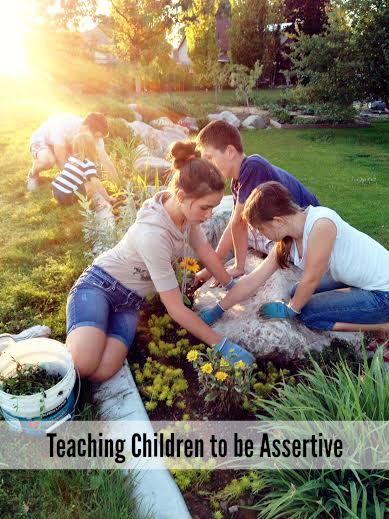Heather Johnson, from the Family Volley and our Parenting Tips Contributor, is sharing a great article today on teaching your child to be assertive.
Heather here from FamilyVolley.com. Today we are talking about a topic near and dear to my heart. At a time when bullying continues to dominate the media and our communities, there is growing need to teach our children to be assertive.
Assertiveness is the healthiest communication style. It is letting people know your wants and needs, and standing up for your opinions while still respecting the rights and opinions of others. Assertive children don’t shy away from defending their points of view. They stand up for themselves. Whether it is because someone has taken their toys, or because they are being picked on.
If we don’t teach our children to be assertive, they tend to be pushovers, to get bullied, OR, to be aggressive.
Assertiveness works in all situations and helps kids navigate everything from play dates to playground arguments to dinner table disasters.
So… As parents, what can we do to help our children be more assertive and stand up for themselves?
First, we have to model assertive behavior. We have to stand up for ourselves and use good manners while we are doing it. In restaurants when ordering food, when returning things, etc…
Second, work to stop the Peer Worship. Kids tend to shy away from standing up for themselves because they want to fit in or be like someone else.
Teach them it is okay to decide for themselves and that they won’t loose friends over it or be liked any less if they disagree.
If your child won’t take a stand, even though you are teaching them to, teach them not to give in, explain that while a friend may get annoyed, even angry, she probably won’t stop liking her. Ask your child how she feels when you don’t let her get her way-she still loves you, right? Prepare her for the possibility that her playmate will reject her, and explain that a friend who doesn’t respect other people’s opinions isn’t worth having.
Third, let them make decisions. If we always tell our children exactly what to do and what to say, they never learn how to take charge themselves. We need to let them make decisions so they learn to trust that they can.
Fourth let them practice at home. Home is a great place for them to make decisions and should be a safe place for expression.
Teach them to speak their mind, but use kindness and consideration. If we shoot them down every time they have an opinion that is different from ours, they will stop being assertive and expressing their opinions.
PRACTICE around the dinner table. Ask your children questions (favorite color and why. Favorite ice cream and why, what would you do with a million dollars, and why)
Open ended questions shows our children there can be more than one right answer in life and that they can come to their own opinion. This will teach them to trust themselves. Being able to stand up for what you believe-without alienating others- is the ultimate badge of assertiveness.
Fifth, Role Play. Practice situations so your children learn what to say and how to stand up for themselves.
Choose different situations that they will face. Such as …When they want to play with someone…When someone is being unkind to them…Practice a bully situation.
Role Play empowers our children.
Sixth, Practice in Real Life. Let them order their own food, practice please and thank you. My dad was soooo good at this. From a very young age we would order our own food and handle phone conversations ourselves. And now we practice with our kids all the time. In fact, we just sent our 9 year old into pick up a pizza last weekend. She had to ask the people in the restaurant if they were in line, and we even asked her to open the box to check that the order was correct. These are such good learning experiences for them.
The goal is to teach them to make their needs known, by still being polite.
Last, Teach “I” Statements. When kids begin statements with “I” rather than “You” they are standing up for themselves and are being assertive rather than aggressive or mean. Sending an “I” message is a way to let others know how they feel. It does not judge or attack.
This is how it works.
I feel … (state the feeling)
when you … (describe the action)
because I … (say why)
Then as kids get older, add I want/need or would like you to … (say what would make things better).
For example…
“I feel angry + when you take my book + without asking, because I don’t do that to you! + I need you to stop taking my things.”
“I “statements can be used in every area of our children’s lives.
Put some emphasis on assertiveness and help safeguard your children from tough situations and give them the confidence to stand up for themselves.
Have a question, or just want to say hello? You can find me at FamilyVolley.com. On Pinterest, Facebook, and Twitter. Or send me an email. I love making new friends.
JOIN OUR NEWSLETTER
Would you like more Recipes, DIY, Printables and Organization Ideas?
Subscribing to the newsletter will enable us to periodically send you creative content exclusively for Idea Room subscribers.
*View our Privacy Policy here.








Great article! It is so important our kiddos learn these great tips, like you said at a young age! I LOVE your advice, and my husband and I have been trying super hard to teach our children some of these great tips! I can’t wait to start working with them on the other ones you have introduced! Awesome, awesome! Thank you so much for sharing!
What would you suggest a child should say/do when being bullied?
Being assertive is an essential skill to overcome the bullying problem. Work with your kids, guys, make them stronger as sadly this world is not a nice place anymore!
Bennett- Thanks for your suggestions.
You should always leave some of the decision up to children. Don’t punish them if anything goes wrong, but show them how their decisions have consequences!
Carmine- Great tips. Thanks for sharing.